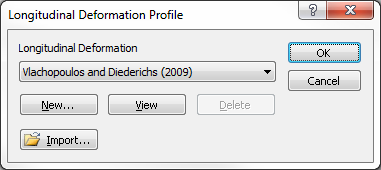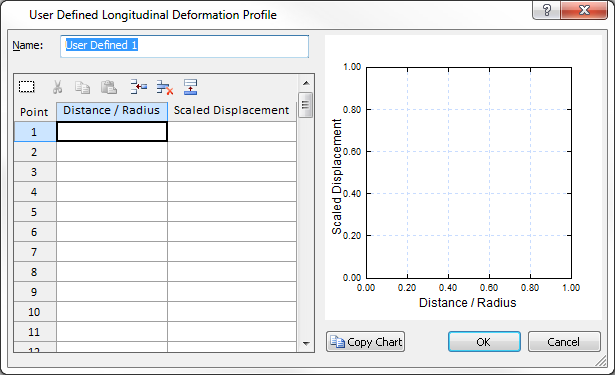Longitudinal Deformation Profile
A Longitudinal Deformation Profile (LDP) is a plot of the tunnel wall convergence along the length of the tunnel (i.e. convergence versus the distance from the tunnel face). An LDP is only used in RocSupport when the method of Support Installation = Distance from Tunnel Face. The LDP function is used to convert the Distance from Tunnel Face into a value of Tunnel Convergence at the point of support installation.
In RocSupport you can choose from one of four built-in pre-defined LDP functions, or create a user-defined LDP function.
To select or define an LDP function:
- In the Support Parameters dialog, set the method of Support Installation = Distance from Tunnel Face.
- Select the Advanced button
 (beside the Distance from Tunnel Face option).
(beside the Distance from Tunnel Face option). - You will see the Longitudinal Deformation Profile dialog.

- In this dialog, you can select, edit or define LDP functions, as described below.
Built-In LDP Functions
Different researchers have proposed a variety of methods for determining longitudinal deformation profiles. In RocSupport you can choose from one of the following pre-defined LDP functions:
- Vlachopoulos and Diederichs (2009)
- Chern et al (1998)
- Panet (1995)
- Unlu and Gercek (2003)
The Vlachopoulos and Diederichs (2009) method is the default and recommended method, as it takes into account the radius of the plastic zone. The analysis will automatically use this function if you do not specify a different function.
The Chern et al (1998) method was the previous default method used in RocSupport version 3.007 and earlier versions.
The Panet (1995) and Unlu and Gercek (2003) methods are based on elastic analysis, and can be used for rock masses in which significant failure is not expected.
For the theory and equations behind these methods, see Vlachopoulos and Diederichs (2009) and the other papers listed in the reference section.
NOTE:
- To view a plot of the currently selected LDP function, you can select the View button in the Longitudinal Deformation Profile dialog.
- If you do not wish to use one of the built-in LDP functions, you can create a user-defined LDP function, as described below.
User Defined LDP Functions
To create a user-defined LDP Function:
- Select the New button in the Longitudinal Deformation Profile dialog.
- This will display the User Defined Longitudinal Deformation Profile dialog.

- Enter a Name for the function.
- Define the function by entering values in the grid. NOTE:
- The X-axis of the function (Distance / Radius) is the distance along the tunnel, divided by the tunnel radius. These values will (in general) begin with negative values, because the starting value of distance is "ahead" of the tunnel face. Zero represents the position of the tunnel face, and positive values represent distance behind the tunnel face (i.e. the excavated part of the tunnel).
- The Y-axis of the function (Scaled Displacement) is the normalized wall displacement. All displacements are divided by the maximum tunnel wall displacement. Therefore the values will range between 0 and 1.
- As you enter data in the grid, the function will automatically be plotted in the graphing area at the right of the dialog. Note: on the graph the data points can be graphically edited, if desired, by clicking on them and dragging them with the mouse.
- When all values have been entered, select OK to return to the Longitudinal Deformation Profile dialog.
- The Name of the new function will appear in the drop-list in the Longitudinal Deformation Profile dialog.
- To apply a user-defined LDP function, select the function name from the drop-list, and select OK to return to the Support Parameters dialog.
To edit, delete or import user-defined LDP functions:
- Edit - to edit a user-defined LDP function, select the function name from the drop-list, and select the Edit button. This will open another dialog, in which you can edit the LDP function.
- Delete - to delete a user-defined LDP function, select the function name from the drop list, and select the Delete button. The function will be deleted from the list.
- Import - to import LDP functions from other RocSupport files, select the Import button, and open an existing RocSupport file.